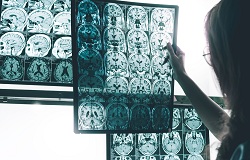New brain visualisation of Alzheimer’s, at different ages, holds out hope for faster diagnosis and treatment
The prevalence of Alzheimer’s disease (AD) is increasing and is most common in the elderly. AD has various symptoms, often reflective of the life-stage of the sufferer when the disease initially presents itself. This variation presents a treatment challenge, especially for younger patients, in whom it is often difficult to reach a correct diagnosis. Researchers supported by the work of the EU-funded BIOFINDER (Biomarkers For Identifying Neurodegenerative Disorders Early and Reliably) project, have succeeded in developing a methodology to visualise AD in the brain at different ages, publishing their findings in the journal of neurology Brain. Imaging disease onset and progression Prior to the age of 65, sufferers tend to experience reduced spatial perception and diminished orientation. Older patients are more inclined to have symptoms traditionally associated with the disease, especially memory impairment. This research means that as one of the research team Michael Schöll, based at Lund University and the University of Gothenburg summarises, ‘Now we have a tool which helps us to identify and detect various sub-groups of Alzheimer’s disease. This facilitates the development of drugs and treatments adapted to various forms of Alzheimer’s.’ A known indicator for the establishment of Alzheimer’s is when the brain’s tau protein creates neurofibrillary tangles or lumps, inhibiting the functioning of the synapses and neurones, the brain’s signalling devices. These are identifiable using new imaging techniques, including the usage of a positron-emission tomography (PET) camera along with the deployment of a molecule acting as the trace substance. The molecule binds to tau which the PET camera can capture. ‘The changes in the various parts of the brain that we can see in the images correspond logically to the symptoms in early onset and late onset Alzheimer’s patients respectively’, elucidates Professor of Neurology, Oskar Hansson, at Lund University and the BIOFINDER project coordinator. The findings are based on the study of around 60 Alzheimer’s patients at Skåne University Hospital, Sweden, along with 30 people who displayed no cognitive impairment acting as a control group. Working towards clinical application As well as placing a tremendous strain on patients and their families, neurodegenerative disorders such as dementia and Parkinson’s Disease, are also a burden for health-care systems. Yet despite investment into treatments - typically drug therapies - none have proved to be successful in arresting or retarding the progress of the diseases. Disappointment also extends to a lack of effective early detection for underlying disease pathologies and scant knowledge about the precise disease mechanism in humans. Yet, many neurodegenerative disorders have distinct and known development pathways which emerge as much as 10-15 years before clinical symptoms are overtly manifested. This means there is opportunity for early diagnosis and so also effective treatment. New therapies hope to exploit this intervention window using biomarkers for early diagnosis. Early treatment, would help avoid unnecessary tests, reducing patient anxiety and uncertainty. At the moment, the imaging technique has only been applied in research settings, where it can be used to help identify patients more likely to respond to new therapies as well as to quantify relevant drug targets, such as oligomers of β-amyloid and α-synuclein. However, Professor Hansson believes that after clinical trials, actual clinical applications are likely within a few years. For more information, visit: The Swedish BIOFINDER study website
Countries
Sweden



